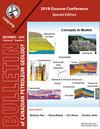蒙特尼致密气和烃类液体通道热成熟度系列的有机岩石学和扫描电镜成像
Q3 Earth and Planetary Sciences
引用次数: 58
摘要
摘要尽管页岩气系统是商业油气生产的新目标,但随着热成熟度的提高,这些非常规系统的演化却很少受到关注。本研究报告了德国北部下托阿尔阶(下侏罗纪)Posidonia页岩在不同热成熟度水平(0.5-1.45%Ro[镜质组反射率])下的样品特征。使用聚焦离子束扫描电子显微镜(FIB-SEM)和透射电子显微镜(TEM)的原始组合进行观察。我们记录了随着成熟度的增加,与干酪根残留物密切相关的微裂缝填充沥青的形成。孔隙率从未成熟样品中的大多数亚微米颗粒间孔隙演变为过成熟(气体成熟)样品中的矿物内和有机内孔隙(在焦沥青块的大分子结构中出现的约1至200nm的不规则形状孔隙)。这种有机内纳米孔隙率很可能是由气态碳氢化合物的出溶产生的,并且在热成熟过程中是碳氢化合物湿的。所调查样品的矿物学组合随着热成熟度的增加而强烈演化。石油和天然气成熟样品中大多数矿物相的形成被解释为在约140至180°C的温度下由富含硫酸盐的蒸发岩衍生的盐水渗透而成。尽管FIB-SEM和TEM图像与现场尺寸相比较小,但本研究强调了纳米级成像的必要性,以更好地约束气页岩系统中的生烃过程。本文章由计算机程序翻译,如有差异,请以英文原文为准。
Organic petrography and scanning electron microscopy imaging of a thermal maturity series from the Montney tight-gas and hydrocarbon liquids fairway
Abstract Although shale gas systems constitute a new target for commercial hydrocarbon production, only a little attention has been paid to the evolution of these unconventional systems with increasing thermal maturation. This study reports the characterization of samples of the Lower Toarcian (Lower Jurassic) Posidonia Shale from northern Germany at varying levels of thermal maturity (0.5–1.45%Ro [vitrinite reflectance]). Observations were made using an original combination of focused ion beam–scanning electron microscopy (FIB-SEM) and transmission electron microscopy (TEM). We document the formation of microfracture-filling bitumen in close association with kerogen residues with increasing maturity. Porosity evolves from mostly submicrometric interparticle pores in immature samples to intramineral and intraorganic pores (irregular-shape pores of about 1 to 200 nm occurring within the macromolecular structure of pyrobitumen masses) in overmature (gas mature) samples. This intraorganic nanoporosity has most likely come about by the exsolution of gaseous hydrocarbon and been hydrocarbon wet during the thermal maturation processes. The mineralogical assemblage of the investigated samples strongly evolves with increasing thermal maturity. The formation of most of the mineral phases within the oil and gas mature samples is interpreted as resulting from the percolation of sulfate-rich evaporite-derived brines at temperatures of about 140 to 180°C. Although FIB-SEM and TEM images are small compared to field size, the present study emphasizes the need for nanoscale imaging to better constrain hydrocarbon generation processes in gas shale systems.
求助全文
通过发布文献求助,成功后即可免费获取论文全文。
去求助
来源期刊

Bullentin of Canadian Petroleum Geology
Earth and Planetary Sciences-Geochemistry and Petrology
CiteScore
2.50
自引率
0.00%
发文量
0
期刊介绍:
The Bulletin of Canadian Petroleum Geology is a peer-reviewed scientific journal published four times a year. Founded in 1953, the BCPG aims to be the journal of record for papers dealing with all aspects of petroleum geology, broadly conceived, with a particularly (though not exclusively) Canadian focus. International submissions are encouraged, especially where a connection can be made to Canadian examples.
 求助内容:
求助内容: 应助结果提醒方式:
应助结果提醒方式:


